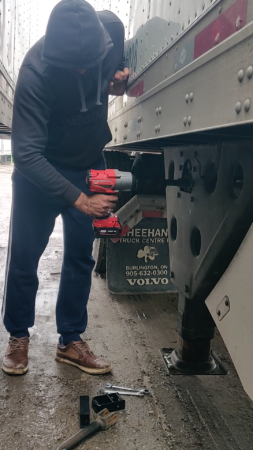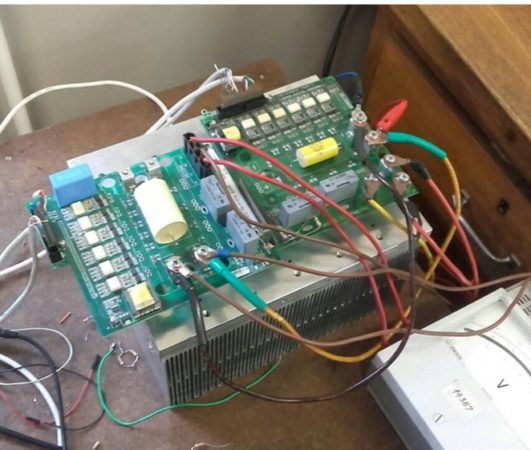Canadian developing electric landing gear
TORONTO, Ont. – A Canadian tech start-up is looking to electrify landing gear, and has developed a currently available adaptor to ease the job for drivers.
Omid Beik, founder of Enercs, first became aware of the demands of deploying landing gear when reading about the Humboldt Broncos bus crash, in which 16 people were killed following a collision with a semi.

“One person said these drivers, they work 14 hours a day, they’re exhausted. Then at the end of the day the have to crank landing gear. That was my first introduction to landing gear,” Beik said in an interview with Trucknews.com. Beik, who has a Ph.D and a masters in electric motors, felt “There has to be a better way to do it.”
He discovered it takes 100 lb.-ft. of torque to properly lower the landing gear.
“That is massive for any human being to operate,” he said.
Beik reached out to trucking fleets, which expressed support for a product that would make cranking the landing gear easier, as long as it was priced reasonably. Other products on the market cost US$675. So Beik invented an adaptor that fits on any electric impact wrench. The driver simply attaches the impact wrench (not included) to the adaptor and then can raise or lower the landing gear quickly at the press of a button.
It retails for $49.99 and is available today (orders currently must be placed via email, at sales@enercs.com).
But Beik has grander visions for the application and is currently working on an electric motor that will tap into the truck’s 12-volt power source. He has built a rare earth-free electric motor, which reduces cost significantly.
“Thirty to 50% of the price of the motor is the magnets, we eliminate that,” he explained.
The company now has five patents pending. Biek hopes to commercialize the electric system within a year, and is in talks with landing gear manufacturers to integrate. Eventually, as trucks become more automated, Biek feels autonomous landing gear will be required. But that brings challenges such as theft prevention, which the company addresses through use of an RFID tag assigned to a driver.
Work continues on the electric landing gear, with all the company’s manufacturing and development taking place in Concord, Ont.

Have your say
This is a moderated forum. Comments will no longer be published unless they are accompanied by a first and last name and a verifiable email address. (Today's Trucking will not publish or share the email address.) Profane language and content deemed to be libelous, racist, or threatening in nature will not be published under any circumstances.
-
you may be able to do it quickly for ones or twice per load but I am working in a job doing a mechanical repair for a company that every driver has to hook on 3 different trailers per night and drop each tailer on weight bridge twice they have to wind the landing legs over 20 time per night I think it is a fatastic idea for those who work with truck plus having the ratel gun in the truck increase the potential for the driver to check the wheel nuts/ less flying wheels on the roads
My father developed and patented a prototype pneumatic dolly leg system, over 30 years ago.
It used an air spring similiar to the trailer air spring with few moving parts for maintenance ease.
It was developed to reduce the chance of back injury to a driver.
Not one single trailer manufacturer he approachedwas interested in pursuing the idea.
Here we are, 30 years later, basically using the same technology that has been in place about 75 years.
Sure does take our industry a long time to accept new ideas in some areas does it not?
I would be concerned about the gear-train in the dolly leg being damaged by the impact blows from the cordless impact gun – the gears are not made of the same grade of steel as impact sockets, nuts, bolts etc are made of. Give it time and cold temperatures, the gears will chip or shatter.
A Cordless drill would likely trade back and shoulder injuries for wrist injuries.
A fully-baked OEM supported solution supplied with the trailer from factory would be the way to go.
Interested on most recent progress and development of electric landing gear. How soon will it be available for retail?
Good Luck I can lower them quicker by hand, . then taking off the crank handle then using a drill. Companys are not going to hand every driver, a new drill to do the job.